To win football games, the defense needs to control the line of scrimmage. Understanding defensive fronts and how players align is a major part of controlling the line of scrimmage.
The 3 main defensive fronts that football coaches use are the under front, over front, and tite front.
The defensive line is the most important group of players on the defense. Stopping the offense’s running attack is the primary goal of the defense. The teams who cannot successfully stop the run often lose the field position game and the time of possession game.
Also, generating a pass rush and controlling gaps so running backs can’t run freely requires great technique and a solid scheme.
Similar to how an offense has a play script detailing each player’s job, the defensive line has responsibility.
To stop the run, the defensive line must control gaps ( the spaces between each lineman) to understand defensive fronts fully. This forces the running back to slow his feet or run laterally, which is great for the defense.
We’re going to be using the numbering system you learned in the previous lesson ( 1, 2i, 3, etc.) to identify techniques. I know the numbering system for defensive alignments; check out this article on alignments and gaps before you continue reading!
Each defensive position has an alignment and assignment based on the front that they’re in. We’re going to detail the most common fronts used in football.
Defensive Fronts In Football
Over Front
The over front is one of the more common fronts run out of the 4-3 defense. The 4 defensive linemen will line up in the following techniques:
Defensive Tackles: 1 Technique & 3 Technique
Defensive Ends: 5 Technique
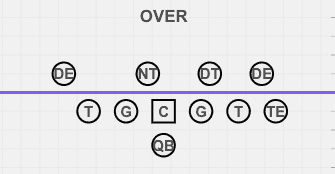
This is a 4 down front, meaning there will be 4 defensive linemen with their hands on the ground. The positions include two defensive ends, a defensive tackle, and a nose tackle.
As shown above, the 3-technique will be set to the tight end side. The 1 technique will be set on the opposite side of the center.
The middle linebacker will have the A gap and will be responsible for any middle runs. The other linebackers will take the remaining gaps. Teams will use the over front as their base defense as it’s a safe defensive scheme. It does however have its faults against spread teams.
Under Front
The under front is similar to the over the front; the only difference is that the 3 technique is now set to the opposite side of the tight end.
Defensive Tackles: 1 Technique & 3 Technique
Defensive Ends: 5 Technique
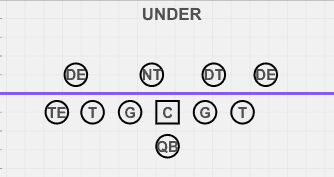
Teams will shift their linebackers to the tight end side if he’s a viable passing threat and play the 3 technique opposite side.
The under front helps to balance out the weak side of the formation, so teams can use their linebackers in the run game or to pass rush. The strongside linebacker (also known as the Sam linebacker) needs to be an outstanding player to hold the edge and play the run game.
These front seven defenders are responsible for their gap assignments and gap responsibilities so the offense can’t run the football.
Field Front
The “field” set is the same as the over/under the front; only the defensive front is set to the field (the side of the field with more space). These fronts are used if there’s no tight end.
Defensive Tackles: 1 Technique & 3 Technique
Defensive Ends: 5 Technique
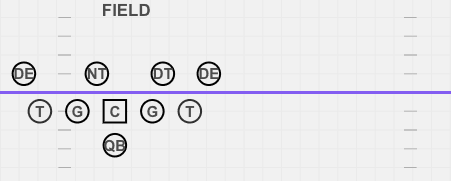
As shown above, the open side of the field has the 3 technique occupying the B gap, and the opposite side is occupied by the 1 technique.
Boundary Front
The boundary set is also the same as the over/under front, except the 3 technique will go toward the “short” side of the field, otherwise known as the “boundary.’
Defensive Tackles: 1 Technique & 3 Technique
Defensive Ends: 5 Techniques
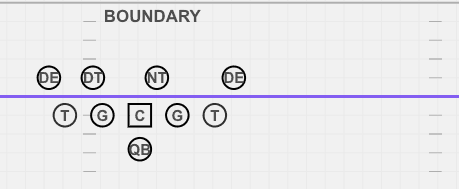
As shown above, the 3 technique will occupy the B gap to the short side of the field and 1 technique to the field side.
Bear Front
The bear front, made famous by the Chicago Bears, requires 3 defensive tackles to occupy the 3 interior offensive linemen ( Center & 2 guards).
Nose Guard: 0 Technique
Defensive Tackles: 2 Techniques
Defensive Ends: 5 Techniques
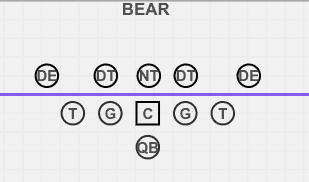
The easiest and most efficient way to identify a bear front is to see if the defense has the center and 2 guards covered.
Tite/Okie Front
Moving into the 3-man fronts, the first scheme is the Tite front. The tight front is one of the more popular schemes to defend against the spread attack.
Nose Tackle: 0 Technique
Defensive Ends: 4i Technique
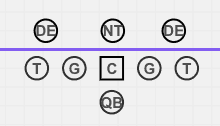
The 0 technique is usually a player that can handle double teams and own 1 on 1 blocking. The 2 4i’s are primarily B Gap players, which can disrupt zone blocking schemes.
The Tite front has three defensive linemen that are responsible for the B gaps. Due to their alignment and defensive philosophy, teams may use this defensive structure to spill everything. This allows the linebackers to scrape to the football and safeties to get involved with the run game.
Stack/Base Front
The stack front is similar to the Tite/Okie front. However, it has the defensive ends either head up or outside alignment of the tackle. This front is common against spread attacks, with teams who like to throw the football.
Nose Tackle: 0 Technique
Defensive Ends: 4/5 Technique

Again, this defense typically requires an excellent nose tackle to play 2 A gaps.
Learn How To Watch Film Properly…
Uncover your opponent’s offensive and defensive tendencies so you can easily build a game plan.
Inside You’ll Find:
- Strategies to pick apart defenses
- How to identify player weaknesses
- How to save time in your weekly breakdowns
What Defensive Front Is The Best?
As mentioned in our defensive formations blog, it depends on your personnel. The best scheme is the one that fits the players, and the coach is the most comfortable coach. If a coach has run a 3-4 scheme his whole life, it may be tough to adjust to the 4-3. It all depends on the coach.
Choosing which defensive front also depends on personnel. If the team doesn’t have enough defensive linemen to play a 5 or 4 man front, it doesn’t make much sense. If the team has many speedy linebackers and defensive backs, it may make sense to play a 3-4.
A coach may play multiple fronts to keep the offense off-balance and use his personnel wisely. Larger teams with more players may have the depth and personnel to rotate players. This gives the coach the freedom to play 3, 4, and 5 man fronts to stop the run and pressure the quarterback effectively.
Keep Learning
It’s important to understand the defensive fronts, as they will help you determine what kind of defensive formation the team you’re watching is in.
If you liked learning football, we recommend you check out defensive courses. These courses will help to improve and solify a foundation for your defense.
Defensive fronts are unique to each defensive coach. Football coaches often copy systems from other coaches. They also innovate and create their own type of fronts.
It’s important to know the basics of lining up to control the line of scrimmage. Football games are won and lost based on what team controls the line of scrimmage. Focus on the line of scrimmage before anything else to be successful in games.
Teams who dominate the line of scrimmage will more than likely dominate the game. If you’re looking to study one thing this off-season, make it the defensive line as well as the offensive line. Understanding offensive line plays and behavior will allow you to gameplan and prepare for the next season.


